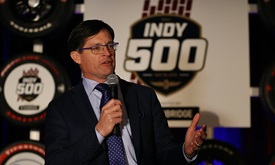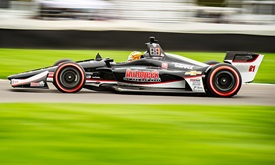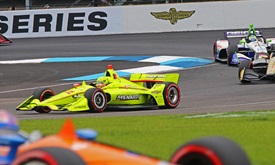You never know what or when Indy 500 memories will be created
MAY 14, 2019
The flags flapped in the wind, extending to temporarily block the rising sun from my eyes.
Snap! The flags would unfurl the opposite direction, granting my pupils temporary reprieve. That’s when I could see the colors. Green. Yellow. Red. Checkered. They dotted the top row of Grandstand E.
It was the first time I’d seen the Indianapolis Motor Speedway. Race day, 1981. My parents, my older sister Juj and I, navigating into the track from our trusted parking spot just west of Main Street in Speedway. I couldn’t believe what my 8-year-old eyes were seeing. That’s the beauty of the place. You never know what you might see. Often, what you do your memory will never relinquish long after your brain has it processed. This is my list of 10 such things at the Indianapolis 500 (ranked chronologically).
10. The man dancing with powder, 1981: That’s what I thought I saw in that race in 1981. I heard the crowd, could feel the panic. Across from our Paddock seats, a man was jumping around frantically while what looked like Pillsbury dough flew through the air. I even said it to my Dad, “He’s dancing in powder.”
Rick Mears wasn’t dancing, he was burning. The methanol fuel burned invisibly in those days, leaving to mystery for a youngster the severity of the matter. Fortunately, Mears and his team survived without life-threatening injuries. I was so awestruck by the chaos that I failed to notice two things: Gordon Smiley led during that caution – the only laps he’d lead in his Indy 500 career – and cars were passed during a later race caution that caused a postrace uproar. Apparently, I wasn’t the only to miss it at the time.
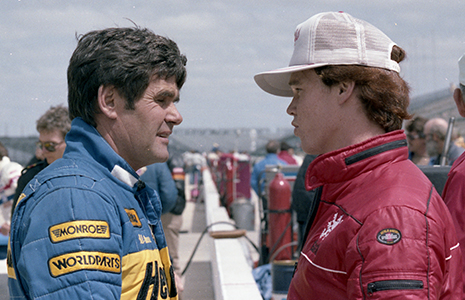 9. “He’s blocking for his Dad!” 1983: Al Unser was going for win No. 4. he looked like my father. Late in the race, Unser was trying to hold off Tom Sneva. That pesky car in between Sneva and Unser? Al Unser Jr., in his first race, several laps down.
9. “He’s blocking for his Dad!” 1983: Al Unser was going for win No. 4. he looked like my father. Late in the race, Unser was trying to hold off Tom Sneva. That pesky car in between Sneva and Unser? Al Unser Jr., in his first race, several laps down.
“Why couldn’t Sneva get past him?” I wondered. “He’s blocking for his dad!” my dad exclaimed.
Sneva would eventually get past for the win. But not before the Unsers’ on-track camaraderie transferred to my own father-son moment.
8. “Spin to Win,” 1985: While the seats my dad secured each year fluctuated in location, I most often sat in Turn 2, the Southeast Vista. That’s where we sat in 1985. Danny Sullivan. Beautiful Miller American March. Passing Mario Andretti. Turn 2. Spin. Straightened. Off again.
No more needs to be said.
7. “It’s finally his day,” 1987: While Al Unser was a sentimental favorite of mine, I was always a fan of Roberto Guerrero. The Colombian had knocked on the door with a second, third and fourth in his first three 500s, and in 1987 looked poised to kick it in.
“It’s finally his day,” I thought to myself as Guerrero pitted on Lap 182, a lap up on the field. You know the result. Stalled. Restarted. Stalled again. The consolation was that it led to Unser’s historic fourth win. Yet, I still wonder how things could have been different for Guerrero had it been his day.
6. “The old vacuum cleaner got him,” 1994: I had never before nor since seen an engine as powerfully fast, yet effortlessly smooth-sounding as the 1994 Penske Ilmor Mercedes-Benz. The Penske drivers dominated the month.
They would have finished 1-2, but when defending race winner Emerson Fittipaldi smacked the wall late, Al Unser Jr. finished for the win without his teammate. It was dirty air that pulled Fittipaldi – “the vacuum cleaner,” as Little Al told ABC. It was the only thing all month to reel in the Mercedes.
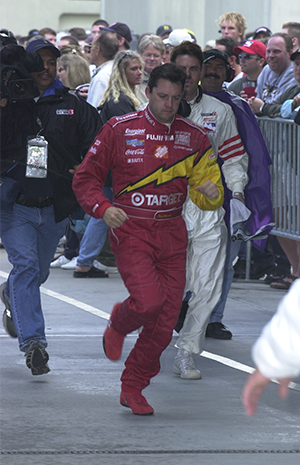 5 “When you gotta go, go when stopped,” 2001: Tony Stewart was trying to finish the first half of his daily double, scheduled to run the NASCAR Coca-Cola 600 after completing the 2001 Indy 500. After leading the race, but waiting out a 17-minute delay, Stewart leaped from his car for what was assumed to be a trip to the men’s room.
5 “When you gotta go, go when stopped,” 2001: Tony Stewart was trying to finish the first half of his daily double, scheduled to run the NASCAR Coca-Cola 600 after completing the 2001 Indy 500. After leading the race, but waiting out a 17-minute delay, Stewart leaped from his car for what was assumed to be a trip to the men’s room.
“When you gotta go, go when stopped!” a guy behind me yelled. Turns out, he was being treated for leg cramps. Stewart went in to finish sixth.
4. “Where did the speed come from?” 2006: It seemed he’d won it five turns earlier. When Marco Andretti slammed the Turn 3, Lap 199 door on Sam Hornish Jr., it looked like the 19-year-old was about to win, in his first Indy 500, what his father had been denied in 14 previously.
You know the result. Hornish roared past him at the line to take the checkered flag. I was there to interview Marco when he unstrapped from his machine and took off his helmet. “Where did the speed (for Hornish) come from?” he asked rhetorically and incredulously. I still don’t know who he was asking. I also still don’t know who has the answer.
3. “ Did I just see that?” 2011: Even as JR Hildebrand sailed past me with just two turns left, I was afraid to call him the winner. “He still has half a lap to go,” I thought to myself while calling his last lap from Turn 2 for the Advance Auto Parts INDYCAR Radio Network. His lead was so big, his fortune so certain, I recall, I hadn’t stopped to think who was running second.
I watched on the big screen at what was to happen next. Hildebrand hit the wall in Turn 4. It felt like the world went silent, only to rush back to reality with one person’s words permeating through your delusion.
“Did I just see that?” my spotter Rob Hendrix asked. I was wondering the same, which was interrupted by my next thought. “Wait? Who won?!” Dan Wheldon.
2. “Dario Franchitti got through that. Takuma Sato did not.” 2012: That’s what I recall saying as I watched Sato’s car slide beneath me while Franchitti rolled out of Turn 2 and on to victory.
Sato took his shot into Turn 1 on the final lap of the Indy 500 seven years ago but went just a little too high. All’s well that ends well. Franchitti became just the 10th driver with at least three wins, while Sato would get his first five years later.
1. “Into Turn No. 4 on fumes!” 2016: I was recalling the 2011 race as the laps of the 100th Indianapolis 500 wound down. Alexander Rossi, like Hildebrand a rookie from California, was nursing his car’s low fuel reading and trying to limp home for an upset victory. 2011 was on all of our minds, as those of us on the radio broadcast were consistently asking who was running behind the leader.
As my co-worker Nick Yeoman passed the broadcast to me from his Turn 2 position to my newer spot in Turn 3, he let me know who to look for: Carlos Munoz and Josef Newgarden, running second and third.
As Rossi rolled ever so slow below me, I was looking for the other two, prepared to see the pass that would close 100 versions of the Indianapolis 500.
As I realized I needed to pass the radio baton to Chris Denari in Turn 4, my own disbelief of observation was all I could think to say: “Alexander Rossi into Turn number four on fumes!” And, he was. Just enough to fuel him to a win for the ages.
As it turns out, Rossi, in car 98, got the win with team owner Bryan Herta. The same Bryan Herta whose other 500 win came with car 98, and Dan Wheldon, in 2011. After Hildebrand hit the wall.
Now, I see the flags when I drive into the oval. At 46, my eyes are more squinted than wide when I see the colors from afar. Nonetheless, my pupils begin to dilate with the same anticipation. Knowing this, too, may be the day they digest for me a vision I’ll process and cherish, not to relinquish from memory anytime soon.
(Veteran broadcaster Jake Query is a member of the Advance Auto Parts INDYCAR Radio Network team and offers his musings regularly on IndyCar.com.)













